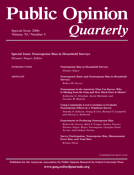-
Views
-
Cite
Cite
Robert M. Groves, Nonresponse Rates and Nonresponse Bias in Household Surveys, Public Opinion Quarterly, Volume 70, Issue 5, 2006, Pages 646–675, https://doi.org/10.1093/poq/nfl033
Close - Share Icon Share
Abstract
Many surveys of the U.S. household population are experiencing higher refusal rates. Nonresponse can, but need not, induce nonresponse bias in survey estimates. Recent empirical findings illustrate cases when the linkage between nonresponse rates and nonresponse biases is absent. Despite this, professional standards continue to urge high response rates. Statistical expressions of nonresponse bias can be translated into causal models to guide hypotheses about when nonresponse causes bias. Alternative designs to measure nonresponse bias exist, providing different but incomplete information about the nature of the bias. A synthesis of research studies estimating nonresponse bias shows the bias often present. A logical question at this moment in history is what advantage probability sample surveys have if they suffer from high nonresponse rates. Since postsurvey adjustment for nonresponse requires auxiliary variables, the answer depends on the nature of the design and the quality of the auxiliary variables.





